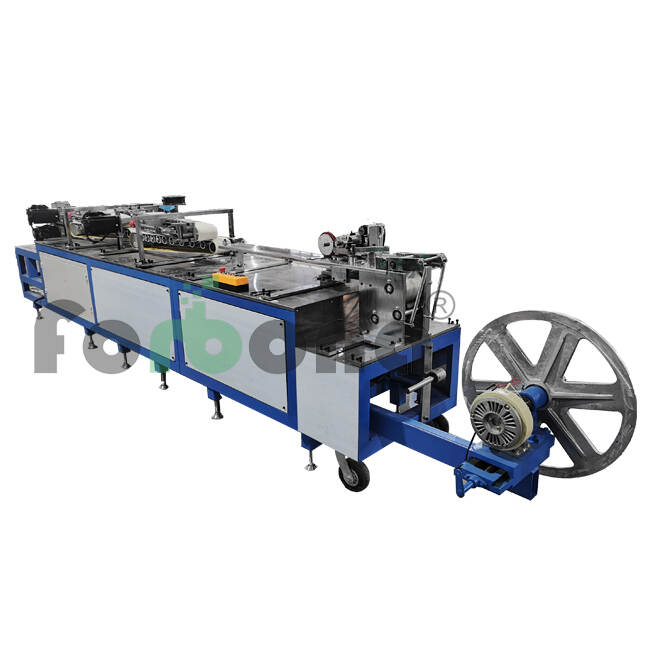Email format error
Email cannot be empty
Email already exists
6-20 characters(letters plus numbers only)
The password is inconsistent
Email format error
Email cannot be empty
Email does not exist
6-20 characters(letters plus numbers only)
The password is inconsistent


Paper Stick Making Machines: Revolutionizing Industries
In today's rapidly evolving industrial landscape, sustainability and eco-consciousness have become paramount concerns for businesses across various sectors. In response to the growing demand for eco-friendly alternatives, paper stick-making machines have emerged as innovative solutions, offering a sustainable alternative to traditional plastic sticks. In this comprehensive guide, we delve into the world of paper stick-making machines, exploring their purpose, working principles, types, and essential components and features.
Introduction to Paper Stick Making Machines
Paper-stick making machines have gained widespread recognition for their pivotal role in revolutionizing industries such as food, medicine, and crafts. Their significance lies in their ability to address the pressing need for sustainable alternatives to plastic sticks, thereby reducing environmental impact and promoting a greener future.
In the food industry, paper sticks are increasingly being used as substitutes for plastic stirrers and skewers due to their biodegradability and non-toxic nature. Similarly, in the medical field, paper sticks are employed in various applications, including specimen collection, wound care, and surgical procedures, where hygiene and safety are paramount. Moreover, in the realm of crafts and DIY projects, paper sticks offer endless possibilities for creative expression, making them popular among artists and hobbyists alike.
The shift from plastic to paper sticks underscores a broader commitment to environmental sustainability and waste reduction. By embracing paper stick-making machines, businesses can not only meet consumer demands for eco-friendly products but also contribute to the global effort to combat plastic pollution and promote a circular economy.
Working Principles of Paper Stick Making Machines
At the heart of paper stick-making machines lies a sophisticated blend of mechanical ingenuity and operational efficiency. These machines operate on a series of mechanical principles, including feed mechanisms, glue application systems, and precision cutting processes.
The feed mechanism is responsible for smoothly advancing the paper material through the machine, ensuring a continuous production flow. Meanwhile, the glue application system meticulously applies adhesive to the paper surface, facilitating the bonding process and ensuring the structural integrity of the sticks.
Central to the operation of paper stick-making machines is the cutting process, which involves precision cutting techniques to shape the paper material into uniform sticks of desired dimensions. This process demands precision and accuracy to ensure consistency in stick size and shape, thereby meeting quality standards and customer expectations.
Operational efficiency is further enhanced by the automation capabilities of modern paper stick-making machines. From semi-automatic models to fully automated systems, these machines offer varying levels of automation to streamline production processes and maximize output rates.

Types of Paper Stick Making Machines
Paper-stick making machines come in a variety of types, each tailored to meet specific production requirements and operational preferences. These include manual, semi-automatic, and fully automatic models, each offering distinct features and benefits.
Manual paper stick-making machines are characterized by their simplicity and ease of operation, making them ideal for small-scale production or startup businesses. With manual control over each production step, operators have greater flexibility and control, albeit at the expense of production speed and efficiency.
Semi-automatic paper stick-making machines strike a balance between manual and fully automatic models, offering increased production capacity and efficiency while retaining some degree of operator control. These machines feature automated feeding, gluing, and cutting processes, reducing manual intervention and enhancing productivity.
Fully automatic paper stick-making machines represent the pinnacle of technological innovation in this field, offering unparalleled levels of efficiency, speed, and precision. Equipped with advanced automation systems, these machines can handle large-scale production volumes with minimal human intervention, making them ideal for high-demand applications.
Components and Features
The seamless operation of paper stick-making machines hinges on the integration of essential components and features, each playing a critical role in the production process.
The paper roll feeder serves as the entry point for raw materials, ensuring a continuous supply of paper material to the machine. Equipped with precision control systems, the feeder enables seamless material handling and optimized production flow.
The glue applicator is responsible for applying adhesive to the paper surface, facilitating the bonding process, and ensuring the structural integrity of the sticks. Depending on the application requirements, various types of glue and application methods may be employed to achieve optimal results.
Central to the cutting process is the cutting mechanism, which utilizes precision cutting techniques to shape the paper material into uniform sticks of desired dimensions. Blade maintenance is crucial to ensure consistent cutting performance and prevent production disruptions.
Finally, the drying unit plays a vital role in the post-production phase, facilitating the drying of freshly manufactured paper sticks to enhance their strength and durability. Depending on the drying method and technology employed, drying times may vary, impacting overall production efficiency.
Conclusion
In conclusion, paper stick-making machines represent a significant advancement in industrial manufacturing, offering sustainable alternatives to traditional plastic sticks across various industries. From food and medical applications to crafts and DIY projects, the versatility and eco-friendliness of paper sticks have made them indispensable in today's eco-conscious world.
By understanding the purpose, working principles, types, and essential components and features of paper stick making machines, businesses can make informed decisions regarding their adoption and integration into existing production processes. Embracing this innovative technology not only promotes environmental sustainability but also unlocks new opportunities for growth, innovation, and market differentiation.
As we look towards a future marked by increasing environmental awareness and sustainability efforts, paper stick-making machines are poised to play a central role in shaping the industrial landscape, driving positive change, and fostering a more sustainable world for generations to come.

